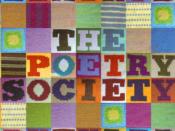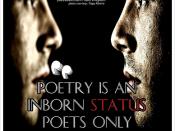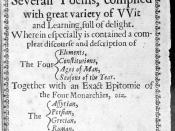The brilliant poet reveals her values and her love for grandchildren through the use of metaphors, repetition, and a persuasive organization. Most of the imagery in the three poems is created by the use of metaphors. By using terms such as "she was but a withering flower," Bradstreet's viewpoints and opinions are emphasized, and furthermore, the text is much more interesting to read than simply stating, "she was a weak being." Lines such as "three flowers, two scarcely blown...", "farewell fair flower...", and "...buds new blown to have so short a date" are also used to indicate the similarity between the children and flowers. Nature is used as well to represent death. In Bradstreet's point of view, the children's deaths are like "plums and apples" that ripe and fall, and corn and grass that is mown. Again, this is much more appealing than a simple, non-metaphorical statement. Secondly, a rolling repetition shown in lines such as "farewell, dear babe...",
"farewell sweet babe...", and "farewell fair flower..." adds to the dramatic love from the writer and calls attention to her point. Last of all, a precise rhyme scheme is used in the poem about Elizabeth. The last three lines of each verse end with exact rhymes, are used for the same reason as the repetition: to significantly stress a point. Moreover, the ending lines of each poem show Bradstreet's philosophy on fate and exposes a positive view of death. The first poem ends with "thou with thy Savior art in endless bliss," showing that even though Anne is deceased, she will experience never-ending happiness. The second poem ends in a similar way, asking Simon to enter endless joy with his sisters. The poem on Elizabeth ends by stating "and buds new blown to have so short a...


